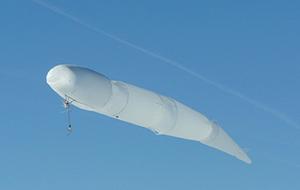Tadpole-shaped dirigible to help in communication, surveillance missions
Florida company shows unmanned dirigible which will fly at 65,000 and 70,000
feet; the “Stratellite” will use similar technology to the that used by the
Graf Zeppelin in the 1930s; homeland security applications include vessel
tracking and cargo container surveillance; littoral (shore-proximate)
surveillance for ports, waterways, coastal trails, and urban environments;
ancillary border surveillance activity, and more

Sanswire-TAO's stratellite Source: impactlab.com
Florida company shows unmanned dirigible which will fly at 65,000 and 70,000 feet; the “Stratellite” will use similar technology to the that used by the Graf Zeppelin in the 1930s; homeland security applications include vessel tracking and cargo container surveillance; littoral (shore-proximate) surveillance for ports, waterways, coastal trails, and urban environments; ancillary border surveillance activity, and more A 111-foot unmanned, sperm-shaped airship prototype, which uses technology from the 1930s golden age of the zeppelin, has completed initial flight testing, according to its makers, Fort Lauderdale, Florida-based Sanswire-TAO, a partnership between Sanswire of Florida and TAO Technologies GmbH of Stuttgart, Germany. The partnership intends to develop so-called “stratellite” droid dirigibles able to hover for long periods in the relatively calm “wind bucket” found between 65,000 and 70,000 feet up. Avoiding the usually punishing stratospheric winds would allow much less fuel to be burned while maintaining position. The resulting long endurance and large area beneath covered by line-of-sight would allow the robot strato-ships to compete with satellites as communications relay platforms — hence the “stratellite” tag.
Lewis Page writes that the STS-111 model, whose initial tests were announced by Sanswire-TAO the other day, is an intermediate step toward the eventual stratocraft, intended for use at lower altitudes as a military surveillance platform. Flight tests had been predicted for the summer, but in the event none were carried out until this month.
The unique tadpole-like appearance of the TAO airships comes from their “segmented” design, said to allow them to flex with wind gusts and thus avoid the control and structural issues which can plague more conventional lighter-than-air craft.
Apart from segmentation, the other main innovation offered by TAO is the “unique weightless Fuelgas system,” though, Page notes, it is far from unique. The same technology was employed successfully aboard the famous Graf Zeppelin airship liner of the 1930s, which ran on a similar gaseous fuel called Blaugas.
Fuelgas, or the zeppelin’s Blaugas, are simply gas fuels mixed to have the same density as air, stored in cells within the ship’s hull instead of hydrogen or helium lift gas. The old Graf filled up to a quarter of its hull with Blaugas; in the STS-111 only the “head” segment holds helium, the tail is full of fuel. As the fuel weighs the same as the surrounding air, its buoyancy supports its own weight — it is effectively weightless. As it is burned in the ship’s engines, its disappearance does not make the ship lighter as would be the case with normal liquid fuel.This is good news, as it means that the ship need not vent off lifting gas to maintain neutral buoyancy as a flight goes on. This meant that the Graf Zeppelin did not need to top up with hydrogen at poorly equipped airfields, and will mean that TAO’s tadpole-craft does not require frequent replenishments of expensive helium.
“We are convinced that the segmented design of the STS-111 and its long-endurance fuel gas powered propulsion system addresses unique security needs that require extended-duration station-keeping,” enthused Sanswire CEO Captain David Christian in a statement. “The commercial STS-111 is designed to stay aloft for more than two days, which gives it a definitive advantage over currently deployed, expensive, fixed-wing drones in intelligence and surveillance missions.”
That may all be so: but it would seem that Sanswire-TAO has been beaten to the punch. Plans for a much bigger, “optionally manned” spy-ship of different design are already well advanced.
Sanswire aims to hold a public demo of the STS-111 at Florida’s Orlando Sanford International Airport in “early 2010.”
The company highlights the homeland security uses of the dirigible. It says that the Stratellites can be delivered preconfigured with a complete communications solution, or tailored to customer specifications to execute a wide variety of homeland security missions. Capabilities include monitoring situations with cutting edge sensors and mapping solutions, and the ability to communicate this vital information to response vehicles and personnel on the ground. Owing to its broad coverage of approximately 125,000 sq. mile, the Stratellite will provide mid-distance and near-shore Maritime Domain Awareness (MDA), including vessel tracking and cargo container surveillance; littoral (shore-proximate) surveillance for ports, waterways, coastal trails, and urban environments; ancillary border surveillance activity; and short-range optical/electronic surveillance including ground moving target indication (GMTI) radar for interdiction of narco-, smuggling, and immigration challenges.
